The MSI Z170A Gaming M7 Review: The Step Up to Skylake
by Ian Cutress on September 21, 2015 12:30 PM EST- Posted in
- Motherboards
- Gaming
- MSI
- Skylake
- Z170
Gaming Performance 2015
Our 2015 gaming results are still relatively new, but the issue of FCLK settings might play a big role here. At launch, the default setting for the communication buffer between the CPU and PCIe stack was 800 MHz, even though Intel suggested 1000 MHz, but this was because of firmware limiations from Intel. Since then, there is firmware to enable 1000 MHz, and most motherboard manufacturers have this - but it is unclear if the motherboard will default to 1000 MHz and it might vary from BIOS version to BIOS version. As we test at default settings, our numbers are only ever snapshots in time, but it leads to some interesting differences in discrete GPU performance.
Alien: Isolation
If first person survival mixed with horror is your sort of thing, then Alien: Isolation, based off of the Alien franchise, should be an interesting title. Developed by The Creative Assembly and released in October 2014, Alien: Isolation has won numerous awards from Game Of The Year to several top 10s/25s and Best Horror titles, ratcheting up over a million sales by February 2015. Alien: Isolation uses a custom built engine which includes dynamic sound effects and should be fully multi-core enabled.
For low end graphics, we test at 720p with Ultra settings, whereas for mid and high range graphics we bump this up to 1080p, taking the average frame rate as our marker with a scripted version of the built-in benchmark.
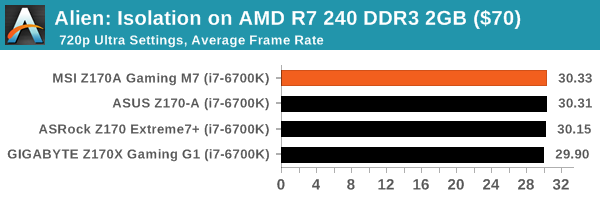
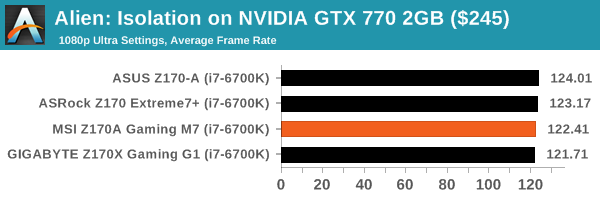
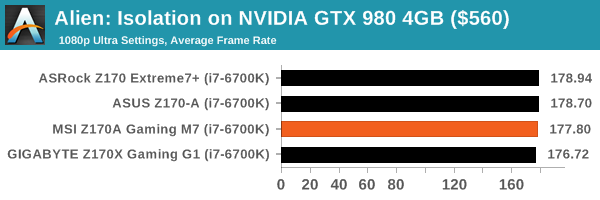
Total War: Attila
The Total War franchise moves on to Attila, another The Creative Assembly development, and is a stand-alone strategy title set in 395AD where the main story line lets the gamer take control of the leader of the Huns in order to conquer parts of the world. Graphically the game can render hundreds/thousands of units on screen at once, all with their individual actions and can put some of the big cards to task.
For low end graphics, we test at 720p with performance settings, recording the average frame rate. With mid and high range graphics, we test at 1080p with the quality setting. In both circumstances, unlimited video memory is enabled and the in-game scripted benchmark is used.
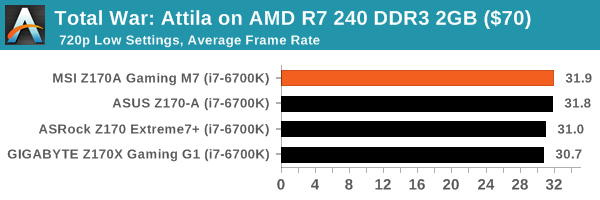
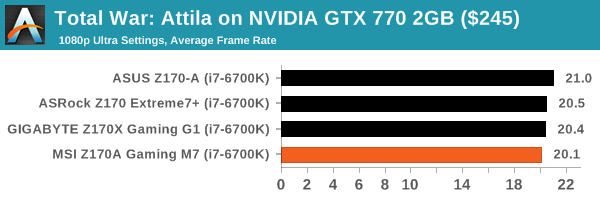
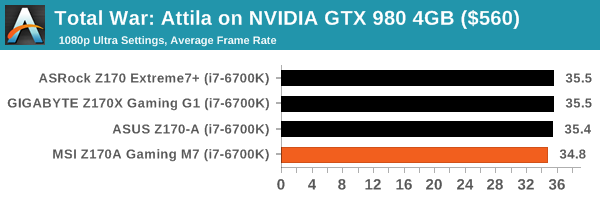
Grand Theft Auto V
The highly anticipated iteration of the Grand Theft Auto franchise finally hit the shelves on April 14th 2015, with both AMD and NVIDIA in tow to help optimize the title. GTA doesn’t provide graphical presets, but opens up the options to users and extends the boundaries by pushing even the hardest systems to the limit using Rockstar’s Advanced Game Engine. Whether the user is flying high in the mountains with long draw distances or dealing with assorted trash in the city, when cranked up to maximum it creates stunning visuals but hard work for both the CPU and the GPU.
For our test we have scripted a version of the in-game benchmark, relying only on the final part which combines a flight scene along with an in-city drive-by followed by a tanker explosion. For low end systems we test at 720p on the lowest settings, whereas mid and high end graphics play at 1080p with very high settings across the board.


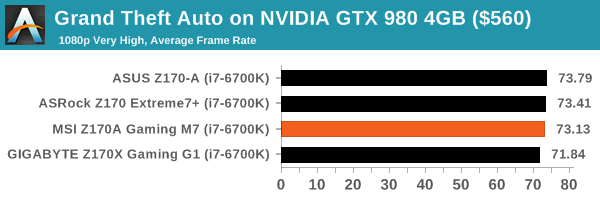
GRID: Autosport
No graphics tests are complete without some input from Codemasters and the EGO engine, which means for this round of testing we point towards GRID: Autosport, the next iteration in the GRID and racing genre. As with our previous racing testing, each update to the engine aims to add in effects, reflections, detail and realism, with Codemasters making ‘authenticity’ a main focal point for this version.
GRID’s benchmark mode is very flexible, and as a result we created a test race using a shortened version of the Red Bull Ring with twelve cars doing two laps. The car is focus starts last and is quite fast, but usually finishes second or third. For low end graphics we test at 1080p medium settings, whereas mid and high end graphics get the full 1080p maximum.

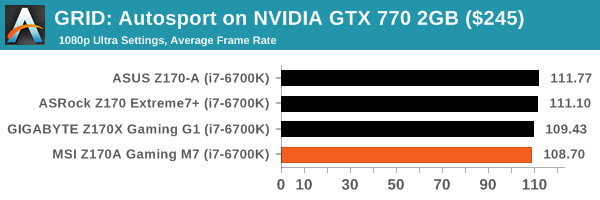

Middle-Earth: Shadow of Mordor
The final title in our testing is another battle of system performance with the open world action-adventure title, Shadow of Mordor. Produced by Monolith using the LithTech Jupiter EX engine and numerous detail add-ons, SoM goes for detail and complexity to a large extent, despite having to be cut down from the original plans. The main story itself was written by the same writer as Red Dead Redemption, and it received Zero Punctuation’s Game of The Year in 2014.
For testing purposes, SoM gives a dynamic screen resolution setting, allowing us to render at high resolutions that are then scaled down to the monitor. As a result, we get several tests using the in-game benchmark. For low end graphics we examine at 720p with low settings, whereas mid and high end graphics get 1080p Ultra. The top graphics test is also redone at 3840x2160, also with Ultra settings, and we also test two cards at 4K where possible.
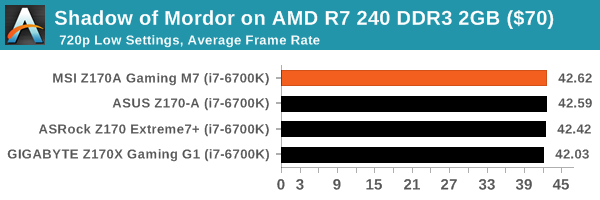
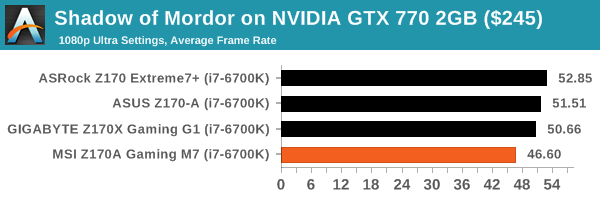
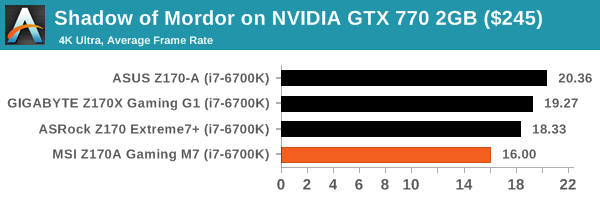
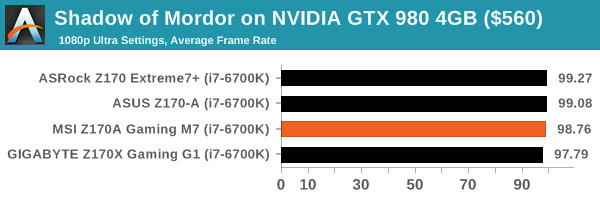
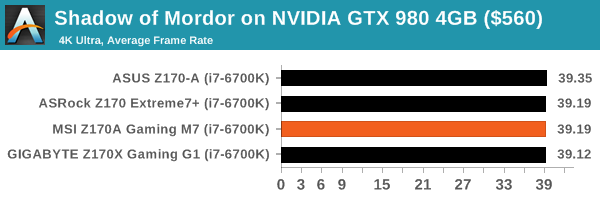
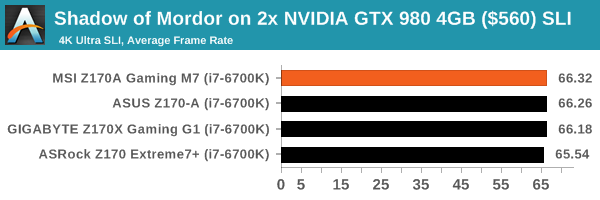















56 Comments
View All Comments
Morawka - Monday, September 21, 2015 - link
The chipset has been upgraded to pci express 3.0 with 20 lanes. the cpu still has it's own dedicated 16x link separate from the 20 lanes to the chipset. the cpu's latency is greatly reduced vs chipset, so that's why graphics cards use it.all the new M.2 drives use the chipset bandwidth now at x4 PCI E 3.0, leaving 16X for more M.2's, Sata, USB, Etc..
DanNeely - Monday, September 21, 2015 - link
You have 16 3.0 lanes on the CPU and up to 20 3.0 lanes on the south bridge. Up to is a very important qualifier; most boards will have significantly fewer available. What the SB has is 26 high speed IO ports that can be used for a sata 3 port, a USB3 port, a PCIe 3.0 lane, or be bundled together for an sata express or m.2 SSD controller. Take all 6 sata ports, all 10 USB3 ports from the chipset and you've only got 10 lanes left for SSD connections or PCIe slots. The maximum configuration for SB lanes is PCIe x4; because the SB itself only has a 4 lane equivalent uplink to the CPU.K_Space - Tuesday, September 22, 2015 - link
Thanks @Morawka and @DanNeely,Am I right in thinking that in this case, if Cross Fire is consuming the 16x lanes from the CPU, then the SSD can get it's x4 PCI-E 3.0 lanes from the PCH (assuming sufficent free lanes which this should have)?
DanNeely - Tuesday, September 22, 2015 - link
yes.K_Space - Tuesday, September 22, 2015 - link
Much obliged.Gigaplex - Tuesday, September 22, 2015 - link
Latency isn't the issue, it's bandwidth. In theory you can use the extra lanes as you describe, but only if the motherboard wires up the lanes correctly. Check the motherboard manual for supported configurations.paulhaswood - Monday, September 21, 2015 - link
Awesome review! Im excited to see more lga1151 motherboard reviews and please please please do a lag 1151 mini itx motherboard review!krbrownin - Tuesday, September 22, 2015 - link
Great timing! I just ordered this board two days ago (and lucked out getting a i7 6700k). I can't wait now to start my build and try it out.I wonder why MSI removed Sound Blaster Cinema and went with this Nahimic audio software? Also I found the Killer Network worked fine if you removed the Qualcomm Suite (that automatically installs with Killer), and installed the plain Killer NIC drivers. I've been using it over a year now that way with not a single prob. Always had good luck with MSI products, so here's hoping that streak continues. It's a good looking board too.
JinzoBlazer - Tuesday, September 22, 2015 - link
Ian, slightly off topic. According to MSI's website the H170-M3 supports unbuffered ECC memory. Is this an error on MSI's part? Any indication if:* This board supports ECC / certain Z170A boards could support ECC with a Xeon (or whatever other CPUs in ARK are listed as having ECC support)?
* H170-M3 just has some extra traces that the Z170-M7 does not? Is there any dependence on chipset for ECC support with an on die "northbridge"?
http://www.msi.com/product/mb/H170-GAMING-M3.html#...
PitneFor - Tuesday, September 22, 2015 - link
people still buy this expensive crap? overclocking? what a huge was of time and money. this article is for the 1% . no one cares anymore about high end "gaming" crap. No one cares about 4k. It's all hype for the industry. you want to stare at tiny icons, text you cant read, and horrible fps so badly ?! and you want to PAY other people money to do this. blows my mind